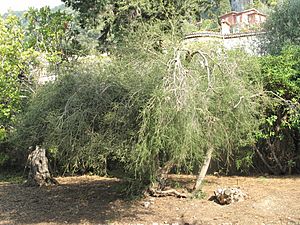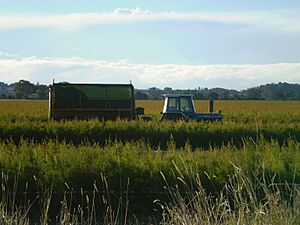Tea tree oil facts for kids


Tea tree oil, also called melaleuca oil, is a special kind of oil known as an essential oil. It has a fresh, strong smell, a bit like camphor. The oil can be pale yellow or almost clear.
This oil comes from the leaves of a plant called the tea tree, or Melaleuca alternifolia. This tree grows naturally in Australia, especially in Queensland and New South Wales.
People started using tea tree oil for business in the 1920s. An Australian named Arthur Penfold was one of the first to sell it. Today, it's a product used around the world.
Tea tree oil is often used as a traditional medicine. People put it on their skin for different skin problems. However, there isn't much scientific proof that it works for many of these uses. Some people claim it helps with things like dandruff, acne, lice, herpes, insect bites, scabies, and skin infections caused by fungi or bacteria. But more research is needed to be sure.
It's important to know that tea tree oil is not an approved medicine in the United States. In Australia, it can be used in aromatherapy as a complementary medicine. It is poisonous if swallowed and is not safe for children to use.
Contents
What is Tea Tree Oil Used For?
Tea tree oil has been used in traditional herbal medicine for things like acne, nail fungus, or athlete's foot. However, there is not much strong evidence to support these uses. One study on acne found it might help a little compared to a fake treatment, but the study wasn't very strong.
The European Medicines Agency suggests that tea tree oil might be helpful for "small cuts, insect bites, and small boils." They also say it might help with mild athlete's foot itching or minor mouth irritation. But they also say that tea tree oil products should not be used on anyone under 12 years old.
It's not recommended for treating nail fungus because it hasn't been shown to work well. It's also not advised for treating head lice in children. This is because we don't know enough about how safe or effective it is for kids, and it could cause skin irritation or allergic reactions.
Is Tea Tree Oil Safe?
Tea tree oil is very dangerous if someone swallows it. It can make a person feel sleepy, confused, or even cause them to pass out. It can also cause shakiness, weakness, vomiting, diarrhea, and skin rashes. It must always be kept away from children and pets. You should never put tea tree oil in or around your mouth.
Putting tea tree oil on the skin can sometimes cause an allergic reaction. This is more likely to happen if the oil is old and has been exposed to air, which changes its chemicals. Allergic reactions can include skin irritation or rashes. Because of this, old or oxidized tea tree oil should not be used.
In Australia, tea tree oil is one of the common essential oils that cause poisoning, especially in children. Many cases of poisoning from essential oils involve tea tree oil.
Tea Tree Oil and Hormones
There are some concerns that tea tree oil might affect hormones. Some studies suggest that certain chemicals in tea tree oil could act like endocrine disruptors. This means they might interfere with the body's natural hormones. This has led to worries about its possible effects on health, especially in young children.
Tea Tree Oil and Animals
Pets like dogs and cats can get sick if tea tree oil is put on their skin, especially in large amounts. They might become tired, weak, shaky, or have muscle tremors. In serious cases, it can even be deadly for them.
Scientists have tested how toxic tea tree oil is by giving it to rats. They found that even a small amount can be very harmful if swallowed.
What is Tea Tree Oil Made Of?
Tea tree oil is made up of many different natural chemicals. The main chemical is called terpinen-4-ol. This chemical, along with a few others like gamma-terpinene and alpha-terpinene, makes up most of the oil. The oil is usually clear to pale yellow and has a fresh, camphor-like smell.
Some of the chemicals in tea tree oil can cause allergic reactions. Oils with less of a chemical called eucalyptol tend to cause fewer problems.
History and How it's Made
The name "tea tree" is used for several plants, mostly from Australia and New Zealand. These plants are related to the myrtle family. The name probably came from Captain James Cook. He described using one of these shrubs to make a drink like tea.
The business of making tea tree oil started in the 1920s. An Australian chemist named Arthur Penfold looked into how useful different native plant oils could be. He found that tea tree oil seemed to have properties that could fight germs, like an antiseptic.
Tea tree oil was first taken from the Melaleuca alternifolia tree in Australia. This tree is still the most important one for making the oil today. In the 1970s and 1980s, large farms started growing M. alternifolia to produce a lot of tea tree oil. Many of these farms are in New South Wales.
Over time, other types of Melaleuca trees have also been used to make similar oils. These include Melaleuca armillaris, Melaleuca styphelioides, Melaleuca leucadendra, Melaleuca acuminata, Melaleuca ericifolia, and Melaleuca quinquenervia. These oils are usually made by a process called water distillation.
The tea tree oil market was worth about $38.8 million in 2017 and is expected to grow even more.
Images for kids



